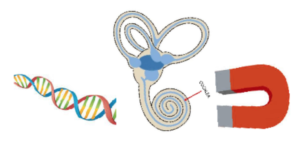New Methods for Getting Drugs, Stem Cells or Genes Into The Inner Ear
From the Labs to the Clinics
Renowned auditory researcher Dr. Robert Harrison brings us up to date on information and research from the Labs. Appropriately titled “From the Labs to the Clinics”, Bob is involved in laboratory and applied/clinical research, including evoked potential and otoacoustic emission studies and behavioural studies of speech and language development in children with cochlear implants. For a little insight into Bob’s interests outside the lab and the clinic, we invite you to climb aboard Bob’s Garden Railway.
There are many reasons why it is desirable to get drugs and perhaps genetic materials into the cochlea. For example, some agents can prevent or reduce cochlear damage, and some might promote the re-growth of cochlear neurons. For the future, if genetic manipulations are found to enable haircell regeneration, these gene promoters will have to be introduced directly to the cochlea.
Some drugs can get to the inner ear with systemic intravenous injection, but most are prevented because of the blood-brain barrier or the related blood-labyrinth barrier. In addition, it is often important to specifically target only the inner ear and avoid agents from a more general spread in the brain and body. This could be extremely important in genetic manipulations designed to reproduce cells in the inner ear but not generally throughout the body.
Local application of certain drugs can be introduced into the middle ear and reach the cochlea by diffusion through the round window membrane. This is not too reliable; much of what is applied drain out through the Eustachian tube, and only drugs of low molecular weight can permeate the round window. It is not feasible to make a cochleostomy and inject it directly into the cochlea, although in the cochlear implant world, ideas about coating electrode arrays with anti-oxidants (to reduce cell damage) or neurotrophins (to promote neuron growth) have been around for many years.
Worldwide there is much ongoing research investigating novel methods to get drugs directly into the cochlea. I want to report two very novel ideas being developed by colleagues at Sunnybrook Health Sciences in Toronto.
The first methodology is being tested by Dr. Alain Dabdoub (Department of Otolaryngology) and his graduate trainee Neha Chauhan. This research involves using focused ultrasound to open the blood-brain barrier and allow a fluorescent adenovirus into the cochlea. Another team has pioneered focused ultrasound at Sunnybrook (led by Dr. Dallan McMahon) for introducing drugs into particular, localized areas of the brain using guidance from magnetic resonance imaging (MRI) [see example ref 1]. The ultrasound signal mechanically disrupts blood vessels' linings such that drugs can pass more from the blood into target brain regions. The experiments on the inner ear (in rat models) show that it is possible to get viral-sized particles across the blood-labyrinth barrier and into the cochlea with this focused ultrasound method.
A different approach is currently being investigated at Sunnybrook by Dr. Trung Le and his team in the Department of Otolaryngology [example ref. 2]. He has the goal of introducing stem cells into the cochlea as a first step towards regenerating the organ of Corti. His team has been experimenting with strong magnets to attract stem cells into the inner ear. The stem cells are tagged with super-paramagnetic nanoparticles that can be attracted by powerful magnets that pull the cells into the inner ear from the adjacent middle ear region.
As with the focused ultrasound approach, the method is still experimental at this stage, but both studies have added to our understanding of how to get drugs or genetic agents directly into the cochlea. In the future, methods such as these might allow direct treatment of inner ear disease with drugs and direct genetic manipulations to promote haircell regeneration.
References
- McMahon D, Bendayan R, and Hynynen K. Acute effects of focused ultrasound-induced increases in blood-brain barrier permeability on rat microvascular transcriptome. Sci Rep 2017;7:45657.
- Le TN, Straatman L, Yanai LA, et al. Magnetic stem cell targeting to the inner ear. J Magnetism Magnetic Materials 2017;443:385–96.


